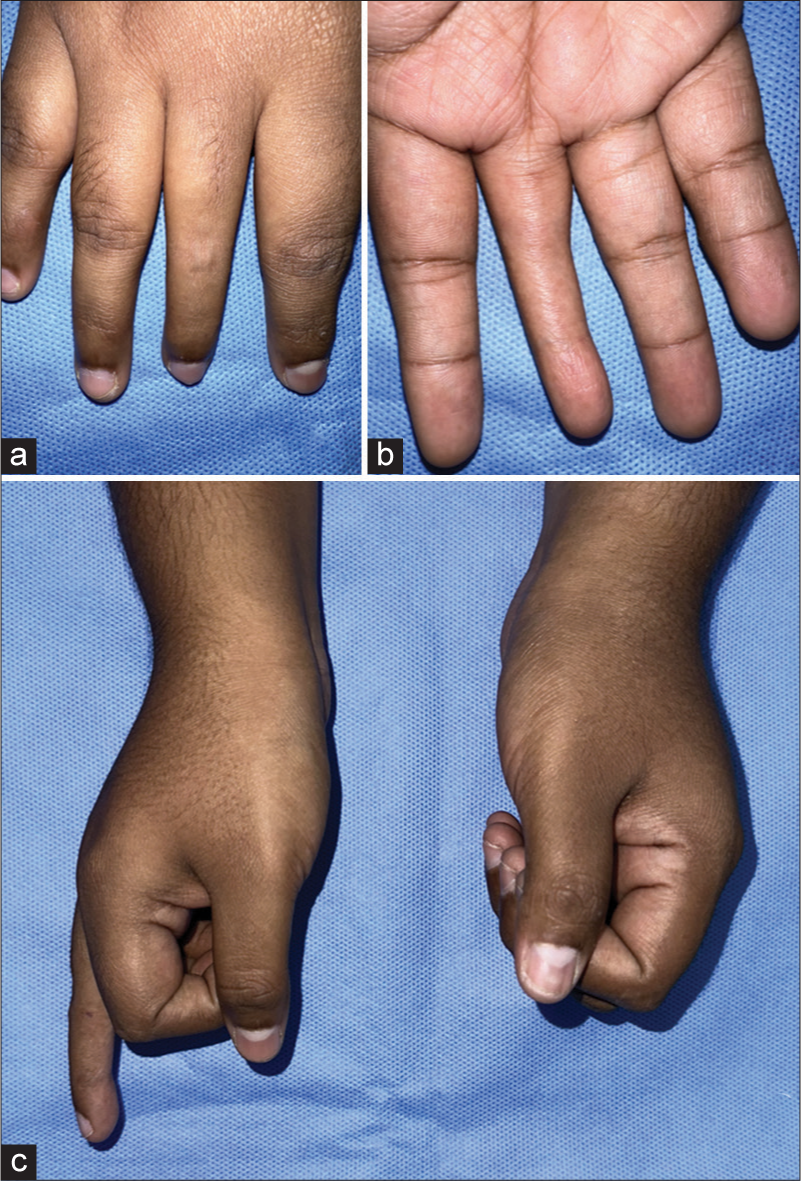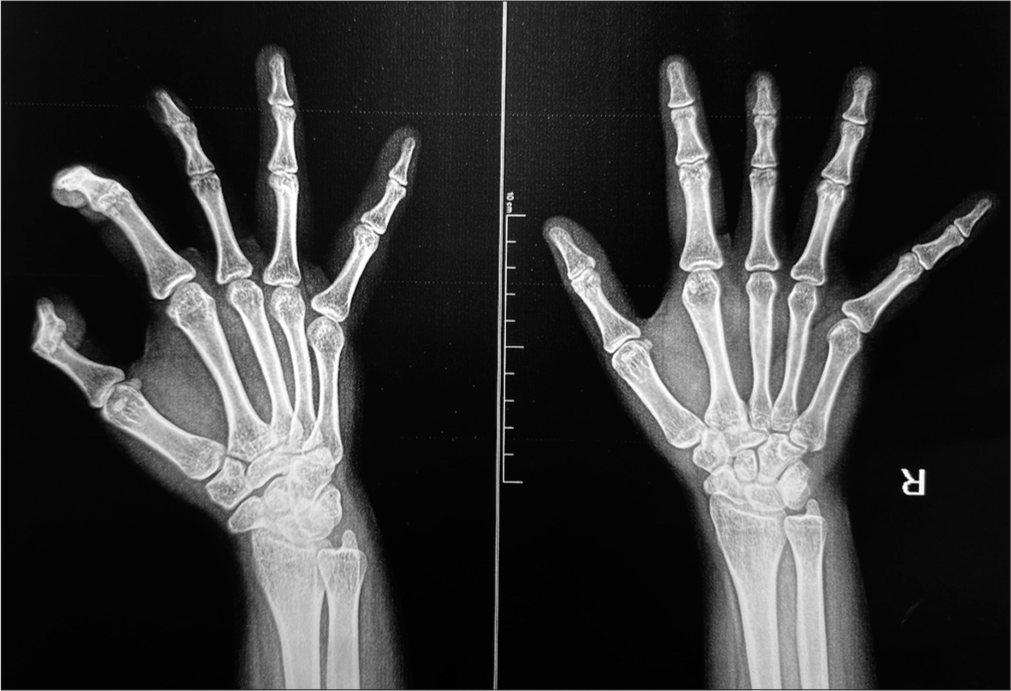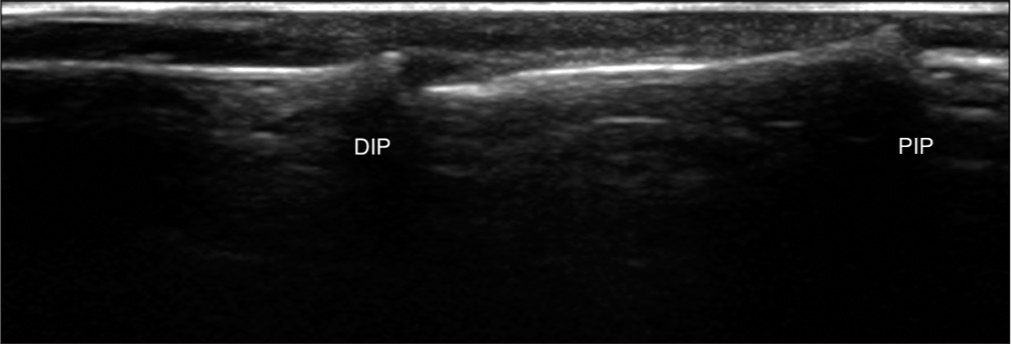Translate this page into:
Congenital absence of flexor and extensor tendons in the middle finger: A rare disorder
*Corresponding author: J. Terrence Jose Jerome, Department of Orthopaedics, Hand and Reconstructive Microsurgery, Olympia Hospital and Research Centre, Tiruchirappalli, Tamil Nadu, India. terrencejose@gmail.com
-
Received: ,
Accepted: ,
How to cite this article: Jerome JT. Congenital absence of flexor and extensor tendons in the middle finger: A rare disorder. J Musculoskelet Surg Res. 2024;8:412-4. doi: 10.25259/JMSR_168_2024
Abstract
Congenital absence of flexor and extensor tendons in the middle finger is a rare disorder that was observed in a 21-year-old female patient. This case involved the missing flexor digitorum profundus, flexor digitorum superficialis, and extensor tendons in the middle finger of the right hand. Despite the absence of these tendons, radiographic imaging revealed a well-formed joint in the affected finger. In addition, the finger displayed hypoplasia and lacked both volar and dorsal skin creases. These findings contribute to understanding congenital hand differences, emphasizing the importance of recognizing such anomalies for accurate diagnosis and tailored management. This case report sheds light on a rare condition that expands the spectrum of congenital hand disorders, paving the way for further research and clinical considerations in similar cases.
Keywords
Congenital absence
Extensor tendons
Flexor tendons
Middle finger
Rare
INTRODUCTION
The previous studies have extensively documented the congenital bilateral absence of flexor digitorum superficialis (FDS) in the little finger and its implications in tendon injuries.[1,2] In addition, there have been limited reports concerning the absence of the flexor pollicis longus (FBL) tendon in the thumb.[3] However, the congenital absence of both flexor and extensor tendons in the middle finger, devoid of associated anomalies, remains a rare phenomenon that has not been previously reported. This report outlines a unique case of congenital tendon absence in the middle finger of a 21-year-old female.
CASE REPORT
A 21-year-old non-consanguineous female presented to our clinic with a non-functioning right middle finger since birth. She was the first daughter of her parents, with no family history of similar congenital anomalies. Her mother’s antepartum was uneventful, with no history of substance intake, fever, or medical conditions. There were no associated syndromes reported. The patient expressed a desire to correct the deformity before her upcoming marriage in a few months.
Clinical examination revealed the absence of volar and dorsal skin creases in the hypoplastic right middle finger [Figure 1]. Radiographic imaging showed well-formed interphalangeal joints and short, hypoplastic metacarpals, and phalanges [Figure 2]. Ultrasound confirmed the absence of extensor and flexor tendons [Figures 3 and 4]. Despite the stiffness, the patient had adapted to this congenital deformity since birth, although with restricted finger-bending activities. She managed to perform daily activities using this hand.

- (a) Clinical images of the dorsum of the right hand illustrate a hypoplastic middle finger with missing dorsal creases. (b) Clinical images of the volar aspect of the right hand depict a hypoplastic middle finger with absent flexor creases. (c) Clinical images of the right hand demonstrate immobility of the middle finger.

- Radiographs of the right hand reveal well-formed proximal and interphalangeal joints of the middle finger. The metacarpal and phalanges appear hypoplastic and smaller compared to the adjacent fingers.

- (a) Ultrasound shows the absence of flexor tendons (Flexor digitorum profundus, flexor digitorum superficialis) in the longitudinal view and well-formed distal interphalangeal joint and proximal interphalangeal joints. (b) Absent tendons and the presence of an empty tendon sheath are noted. DIP: Distal interphalangeal joint, PIP: Proximal interphalangeal joint.

- Ultrasound image demonstrating the absence of extensor tendons and the extensor mechanism in the middle finger. DIP: Distal interphalangeal joint, PIP: Proximal interphalangeal joint.
Treatment options, including ray amputation or tendon reconstruction for the middle finger, were discussed with the patient. However, she declined surgical intervention and opted to manage the condition conservatively.
DISCUSSION
This case presents a unique scenario distinct from previously reported cases of congenital absence of FDS and FPL tendons.[1-4] Unlike those cases, our patient exhibited a total absence of both flexor and extensor tendons in the middle finger since birth, presenting significant challenges in management. Clinically, the middle finger appeared hypoplastic with absent flexion and extension creases. The extension posture of the finger may be attributed to intermetacarpal ligaments between adjacent fingers, rudimentary tendons, or intrinsic muscles (interossei/lumbricals) of the middle finger.
Treatment options, such as ray amputation or staged flexor and extensor tendon reconstruction, were discussed. However, the patient’s impending marriage added complexity to the decision-making process. In our experience, many individuals with congenital anomalies seek corrective surgery before significant life events, such as marriage. However, the expectations associated with such surgeries, including multiple procedures, prolonged therapy, and visible surgical scars, often outweigh the potential benefits.
Given the challenging nature of the case and the patient’s specific circumstances, surgical intervention was not pursued. This decision was made to avoid disappointment due to the inability to meet unrealistic expectations and to minimize the risks associated with complex surgical procedures. Despite the decision to use conservative management, this case is important in recognizing and documenting rare congenital hand differences for future reference and research.
CONCLUSION
The congenital absence of both flexor and extensor tendons in the middle finger, without associated syndromes, represents a rare anomaly. This case underscores the importance of recognizing and documenting such unique presentations, contributing to our understanding of congenital hand differences. Further research and documentation of similar cases will enhance our ability to effectively diagnose and manage these rare conditions.
ETHICAL APPROVAL
The Institutional Review Board approval is not required.
DECLARATION OF PATIENT CONSENT
The author certifies that he has obtained all appropriate patient consent forms. In the form, the patient has given her consent for her images and other clinical information to be reported in the journal. The patient understands that her name and initials will not be published, and due efforts will be made to conceal her identity, but anonymity cannot be guaranteed.
USE OF ARTIFICIAL INTELLIGENCE (AI)-ASSISTED TECHNOLOGY FOR MANUSCRIPT PREPARATION
The authors confirm that there was no use of artificial intelligence (AI)-assisted technology for assisting in the writing or editing of the manuscript and no images were manipulated using AI.
CONFLICTS OF INTEREST
There are no conflicting relationships or activities.
FINANCIAL SUPPORT AND SPONSORSHIP
This study did not receive any specific grant from funding agencies in the public, commercial, or not-for-profit sectors.
References
- Bilateral congenital absence of small finger flexor digitorum superficialis tendons in a trauma patient. Cureus. 2020;12:e6948.
- [CrossRef] [Google Scholar]
- Congenital absence of flexor digitorum superficialis: Implications for assessment of little finger lacerations. J Hand Surg Eur Vol. 2010;35:417-8.
- [CrossRef] [PubMed] [Google Scholar]
- Congenital absence of flexor pollicis longus tendon without associated anomalies of thumb hypoplasia: A case report and review of the literature. Hand (N Y). 2007;2:184-7.
- [CrossRef] [PubMed] [Google Scholar]
- Prevalence of absence of function of the flexor digitorum superficialis muscle tendons in the fourth and fifth fingers of the hand in the Brazilian population. Rev Bras Ortop (Sao Paulo). 2020;55
- [CrossRef] [PubMed] [Google Scholar]






